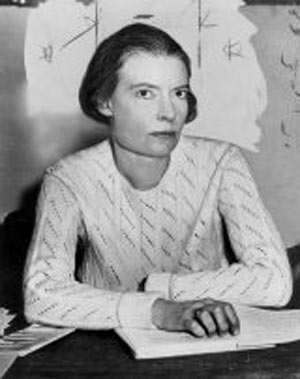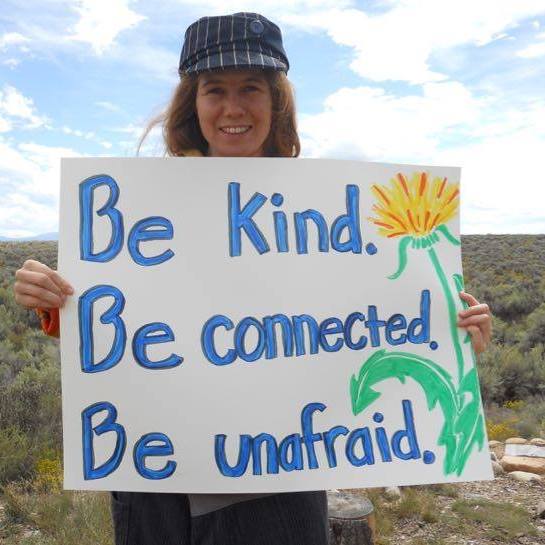
On June 15th, 1955, Catholic Worker founder Dorothy Day joined a group of pacifists in refusing to participate in the civilian defense drills scheduled on that day. These drills were to prepare the citizenry in the event of a nuclear attack, and involved evacuations of city centers, taking shelter in subway tunnels, and, for schoolchildren, “duck-and-cover” to hide under their school desks. Such actions would be futile if a nuclear attack were underway, but the drills were part of a government propaganda program to convince Americans that nuclear weapons were a necessary part of the US arsenal, and that it would be possible to survive a nuclear war.
In this particular case, Operation Alert was a nationwide, mandated, legally enforced drill. Dorothy Day, fellow Catholic Workers and other pacifists informed the media that they would disobey the law, and refused to evacuate public spaces and work places for the proscribed fifteen-minute period. Instead, they sat on park benches in City Hall Park, quietly praying and meditating. All twenty-seven – and a shoeshine man who was taken into custody by mistake – were arrested. They were branded murderers by their judge, who accused them of being responsible for the simulated deaths of three million New Yorkers.
Day said she was doing “public penance” for the United States’ first use of atom bombs in Hiroshima and Nagasaki. She and other protesters plead guilty to the charges, but the judge ultimately refused to send them to jail, saying, “I’m not making any martyrs.” For the next five years, Dorothy Day and many others engaged in similar acts of civil disobedience, refusing to cooperate with the civilian defense drills.
In 1960, more than 600 New Yorkers joined them at City Hall Park, with simultaneous demonstrations at CCNY, Brooklyn College, Queens College, Columbia University and several New York City high schools in noncooperation with the drills. When young mothers with children joined these protests, opposition to the drills increased, and the drills were stopped after the 1961 protest engaged over 50,000 women in 60 cities.
This campaign is an excellent example of the power of nonviolent action, combining noncooperation with drills, civil disobedience of unjust laws, and public acts of protest and persuasion, among others. The pacifists also used letters, speeches, trials, public statements, and interviews to convey the immorality of nuclear weapons and to expose the hidden agenda of the US government. The careful strategizing of noncooperation and protests brought a halt to the civilian defense drills, demonstrating to the US government that the populace would not passively comply with the unspeakable horrors of nuclear weapons.
As we know, the work is far from complete. With one trillion dollars slated for expanding the nuclear arsenal over the next thirty years, it may be time to dust off this chapter of nonviolent history, and tackle modern nuclear challenges by organizing nonviolent action.
More About Dorothy Day
Dorothy Day was born on November 8th, 1897, in Brooklyn, NY. Her family moved twice in her childhood, once to San Francisco, and then to Chicago after he lost his job when the 1906 San Francisco earthquake destroyed the newspaper facilities where he had been employed. Dorothy was an avid reader in her teens and enjoyed Upton Sinclair’s The Jungle. Sheproved a lukewarm university student, however, though she continued to read extensively.
Dorothy Day was involved in social justice causes from a young age. She was imprisoned in 1917 for her actions with Alice Paul’s nonviolent Silent Sentinels during the American Women’s Suffrage Movement. She was sentenced to 30 days in jail, and maintained a hunger strike for 10 of the 15 days she eventually served. In the 1920s, she led a bohemian lifestyle, eventually marrying and having a child, Tamar Teresa, before separating from her husband. She worked as a writer and a journalist to support herself, and it was on one of her assignments for Commonweal that she was led to offer a prayer that was answered with the events of the rest of her life.
Wikipedia reports, “During the Hunger March (of the Unemployed Councils) in D.C. in December 1932, she noted that she was filled with pride watching the marchers, but she couldn’t do much with her conversion. She writes in her autobiography: “I could write, I could protest, to arouse the conscience, but where was the Catholic leadership in the gathering of bands of men and women together, for the actual works of mercy that the comrades had always made part of their technique in reaching the workers?” Later, she visited the National Shrine of the Immaculate Conception in northeast D.C. to offer a prayer to find a way to use her gifts and talents to help her fellow workers and the poor.”
In the 1932, shortly after that experience, she met Peter Maurin, and together, they founded the Catholic Worker Movement, a pacifist movement that combines direct aid for the poor and homeless with nonviolent direct action on their behalf. Within a few years, thirty-three Catholic Worker houses had been established. Criticism of the Catholic Workers’ (and particularly Dorothy Day’s) anti-war stance during WWII dropped that number to only eleven. Today, approximately 120 Catholic Worker communities serve in the United States, with new houses of hospitality opening every year.
On May 1st, 1933, Dorothy Day released the first edition of the Catholic Worker Newspaper. It cost a penny a copy – which is still the price to this day. By the end of 1933, it had a circulation of 100,000 readers. Like the Catholic Worker houses, however, the pacifist stance during WWII caused many to unsubscribe. From the peak readership of 190,000, the circulation plummeted to only 50,000 in 1946.
Through all the challenges, Dorothy Day maintained her faith and commitment to nonviolence, ending poverty, pacifism, and service. When the Catholic Workers rose to confront nuclear weapons development in the 1950s, Dorothy Day was arrested for civil disobedience during a nuclear bomb evacuation drill. The Catholic Worker newspaper had been running articles on racial justice since its inception in 1933 and when the Civil Rights Movement erupted, they continued to support the movement. During the Vietnam War, Dorothy Day supported conscientious objectors and nonviolent actions against the war. Dorothy Day, at the age of 76, traveled to California in 1973 to stand with Cesar Chavez and the striking farm workers where she was arrested and imprisoned for ten days.
She died in 1980 of a heart condition. Her daughter Tamar Teresa was at her side. The Catholic Worker website reports: So many people came to her funeral at Nativity Church in New York City that many had to stand outside on the sidewalk. During her life, Dorothy Day refused to let people “dismiss her as a saint”. At her death, many of her admirers used the word openly. A “permanent revolution” had been initiated by Dorothy’s leadership, grounded in the Sermon on the Mount for which she had “prayed, spoken, written, fasted, protested, suffered humiliation and gone to prison”
This article is from Rivera Sun’s book of nonviolent histories that have made our world. Click here for more information.
______________________________________

Rivera Sun is a change-maker, a cultural creative, a protest novelist, and an advocate for nonviolence and social justice. She’s a love-based revolutionary and the author of The Dandelion Insurrection, The Way Between and ten other fiction, non-fiction and poetry books. Her essays and writings are syndicated by Peace Voice, and have appeared in over a hundred journals nationwide. Rivera Sun speaks and facilitates workshops in strategy for nonviolent change across the country and around the world. She connects the dots between the issues, shares solutionary ideas, and inspires people to step up to the challenge of being a part of the story of change in our times. www.riverasun.com
These are just some of Dorothy Day’s accomplishments during her remarkable lifetime. Learn more about here at https://en.wikipedia.org/wiki/Dorothy_Day
Photo Credit: Dorothy Day in 1934 By New York World-Telegram & Sun Collection – New York World-Telegram & Sun Collection, Public Domain, https://commons.wikimedia.org/w/index.php?curid=5235504
Learn more at: http://www.catholicworker.org/dorothyday/life-and-spirituality.html